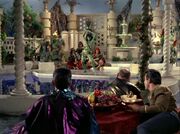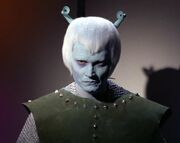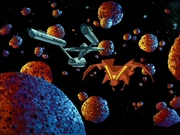m (Robot: Automated text replacement (- ''Enterprise'''s + ''Enterprise''{{'}}s) !!wikia-credits fix!!) |
m (Robot: Automated text replacement (-''Enterprise'' NX-01 +{{EnterpriseNX}}) !!wikia-credits fix!!) |
||
| Line 29: | Line 29: | ||
Human females react negatively to those same pheromones, experiencing headaches, and [[Denobulan]] males find their sleep cycles interrupted by them. [[Vulcan]]s are immune to effects of the pheromones. |
Human females react negatively to those same pheromones, experiencing headaches, and [[Denobulan]] males find their sleep cycles interrupted by them. [[Vulcan]]s are immune to effects of the pheromones. |
||
| − | In [[2155]] [[Phlox|Dr. Phlox]] of the |
+ | In [[2155]] [[Phlox|Dr. Phlox]] of the {{EnterpriseNX}} theorized that the pheromone acts as a defense mechanism against competition. ({{ENT|Bound}}) |
== History == |
== History == |
||
Revision as of 02:01, 6 August 2010
The Orions are a humanoid species originating from the planet Orion.
Physiology and society
Orions are known for their distinctive green or blue skin. Orion males are typically bald and, on average, taller and more muscular than an average Human male. Orion females are very animalistic in nature, known for their extreme carnal appetites and their innate skill of seduction. The Human male can rarely resist the alluring dance of the Orion slave girl. (TOS: "The Menagerie, Part II")
In Orion society, the males are slaves to the females. As a means of deceiving other species, however, the Orions maintain the facade that the females are the slaves. This is commonly done by selling Orion females on the Orion slave market. (ENT: "Borderland", "Bound"; TOS: "The Cage")
Once sold to a male, the Orion slave girls use their unique physiology to their advantage; their highly potent pheromones accelerate the metabolisms of males of many species, raising adrenaline production to dangerous levels which causes aggression and, ultimately, a form of delusion. Its most significant effect is to make them susceptible to suggestion. Not long after, the "owner" males begin taking orders from their "slave" females. The pheromones' effects are cumulative; the longer exposed, the more pronounced are the results.
Human females react negatively to those same pheromones, experiencing headaches, and Denobulan males find their sleep cycles interrupted by them. Vulcans are immune to effects of the pheromones.
In 2155 Dr. Phlox of the Enterprise NX-01 theorized that the pheromone acts as a defense mechanism against competition. (ENT: "Bound")
History

Orion script
The planet Orion was once a highly advanced civilization whose history has drawn great interest from Federation historians and archaeologists alike.
During the mid-23rd century, noted Federation archaeologist Doctor Roger Korby translated medical records from the Orion ruins that helped revolutionize modern immunization techniques and became required reading at Starfleet Academy. (TOS: "What Are Little Girls Made Of?")
In 2269, through the assistance of the Guardian of Forever, Starfleet officers Captain Kirk, Commander Spock and historian Lieutenant Erikson traveled to the dawn of Orion's civilization to view the planet's history unfolding, firsthand. (TAS: "Yesteryear")
During the 24th century, the Orions ran the prestigious Institute of Cosmology, located on Orion I. (VOY: "Good Shepherd")
Politics and commerce
Little is known about the organization of the Orion government, or if indeed a government exists.
Prior to 2270, the Orions had carefully maintained an air of neutrality, especially while operating in and around Federation space. This, however, has proven to be more of a guise than a reality, and was often used as an effort to cover their usually shady operations. Nevertheless, Orion's official position of neutrality comes before ship and crew, as all unsuccessful Orion missions end in suicide. Orions would keep that rationale in good conscience, as they would otherwise fall subject to Federation retaliation, if they were to lose their neutrality. (TOS: "Journey to Babel"; TAS: "The Pirates of Orion")
In an alternate reality, there was at least one Orion cadet, Gaila, in Starfleet Academy during the 2250s. (Star Trek)
Trade entities

Enslaved native dancer at Pike's fantasy establishment on the Orion colony in 2254.
Despite the rich cultural history of Orion and outside of their "official" stance of neutrality, a dark side of the Orion culture exists in their active trafficking of forced labor through the Orion slave markets, especially their slave girls. Verex III and the Orion colony were well-known trade centers during the 22nd and 23rd centuries. (ENT: "Borderland"; TOS: "The Cage")
The primary entity operating within these confines was known as the Orion Syndicate, comprised of a conglomeration of traders, pirates and smugglers. These individuals were well-known for their many illegal operations outside of the slave trade, including extortion, theft, raids, kidnappings and assassinations. (DS9: "The Ascent", "Honor Among Thieves", "Prodigal Daughter") These activities were facilitated in the region of space which separated the Orion Syndicate from the Klingon Empire, known as the Borderland. During the 22nd century, this volatile region of space attracted the most dangerous elements from both sides. (ENT: "Borderland")
In 2154, the Earth starship Enterprise inadvertently made contact with Orion pirates when they encountered a number of Orion interceptors, which kidnapped nine of Enterprise's crew. The crew was recovered from the Orion processing station on Verex III, where they had been taken. (ENT: "Borderland")
A secondary entity operating within the Orion realm was known as the Orion Free Traders. The Orion Free Traders had a partially established relationship with the Vulcans during the late 24th century. (DS9: "Call to Arms")
Trade contacts
The first known Orion contact with Humans was made with Arik Soong during the 2130s. Soong established a relationship with the Orion Syndicate in order to acquire certain goods and equipment that he and his Augments needed to survive. (ENT: "Borderland")
The Orions actively conducted trade with the Earth Cargo Service during the 2150s. In late December 2152, an Orion freighter was scheduled to rendezvous with the ECS Horizon; however the Horizon failed to make the transfer. (ENT: "Horizon")
By the mid-century, certain Orion entrepreneurs, including Harrad-Sar, had made contact with the Gorn Hegemony. (ENT: "Bound")
By 2155, the Orions had established trade with the Coridan "for centuries." That year, during the formation of the Coalition of Planets, the Tellarites pushed for an embargo against the Orions, claiming that several of their freighters had been attacked by the Orions. Considering their long history of trade with the Orions, the Coridan stated that they would have known of these apparent attacks, refusing to believe what they considered to be "Tellarite slander", which they believed was simply a Tellarite attempt to deprive them of valuable commerce. (ENT: "Demons")

An Orion spy surgically altered to look like an Andorian.
Little did the Coridans know that a century later, Orion smugglers were actively raiding dilithium from the Coridan system. The Babel Conference of stardate 3850.3, a prelude to Coridan's admission into the Federation, jeopardized future Orion raids, as Coridan would then become subject to Federation law.
In 2268, the Orions circumvented their neutrality by attacking the USS Enterprise, which was responsible for transporting delegates to the Babel Conference.
Among the delegates was an Orion spy, Thelev, disguised as an Andorian, who in association with an attacking Orion scout ship made a futile attempt to prevent the conference by destroying the USS Enterprise. Had their attack on Starfleet succeeded, they would have instigated mutual suspicion and possibly interplanetary war. Had war broken out, they would have cleaned up supplying dilithium to both sides while continuing to raid Coridan. (TOS: "Journey to Babel")
Loss of neutrality

An old fashioned Orion stand off
Orion's neutrality remained in dispute ever since the Coridan planets affair and the Babel Conference of stardate 3850.3. This was again brought to light in 2270 when an Orion vessel attacked and raided the USS Huron of its cargo of dilithium and a shipment of strobolin intended for transfer to the USS Enterprise.
Following the discovery of the disabled Huron, the Enterprise tracked the Orion ship to an asteroid belt. Initially, the crew was attacked by, and was later accused of harassing, the Orions, who then threatened to file a formal protest with the Federation.
It was when the Enterprise detected the dilithium in the Orion vessel's hold that Captain James T. Kirk told the Orions that he would allow them to keep the dilithium if they would return the strobolin, and would make no mention of the encounter in his log. The Orions did not trust Kirk, and suggested a nearby asteroid to hand over the drug.
This suggestion was a ruse, however, as the Orions planned to destroy themselves and the Enterprise during the exchange to preserve the appearance of Orion neutrality. The plot failed and the Orion vessel and crew were captured, casting further doubt on the future of the Orions' claim to neutrality. (TAS: "The Pirates of Orion")
Mirror universe
In the mirror universe, the Orions had been subjugated by the Terran Empire in 2155. In that year, a female Orion crewmember, possibly a conscript, was serving aboard the ISS Avenger. She was killed while aiding fellow non-Terran under Soval in an attempt to destroy the USS Defiant. (ENT: "In a Mirror, Darkly, Part II")
People
- Named
- Unnamed
List of Orion starships
- Harrad-Sar's barge
- Orion freighter
- Orion interceptor
- Orion marauder
- Orion vessel
- Orion scout ship
- Wanderer class V blockade runner
Appendices
Appearances
Background
In a scene from "The Cage", an illusory Earth trader and a uniformed space officer try to talk Captain Christopher Pike into falling in love with Vina, who, in the series' first depiction of an Orion, appears as an illusory Orion slave girl.
Before being used in filming "The Cage," Vina's green make-up was screen-tested by Majel Barrett. However, when doing tests of the make-up, the film came back three times without the green skin being visible. Angered at this, Fred Phillips had his makeup crew repeatedly paint Majel Barrett with darker shades of paint, hoping it would become visible on screen. It was eventually discovered that the film processing lab had been recolorizing her because they were unaware that she was meant to be green.
The final draft of the episode's script features a different version of the scene from that used in the episode. In the scene as first conceived, the illusory Earth trader teases Pike by suggesting that, as former captain of the starship Enterprise, he used to send Earth "blistering reports," such as "'the Orion traders taking shocking advantage of the natives....'" Intentionally referring to Vina, the illusory space officer asks Pike, "Do any of you have a green one? They're dangerous, I hear." This version of the scene implies that writer and series creator Gene Roddenberry originally conceived the Orions to have more varied colors of skin than just green.
Archive footage of Vina as the illusory Orion slave girl was later used in "The Menagerie, Part II." Later, in "Journey to Babel" featured the first genuine Orion, however he had been surgically altered to appear Andorian. It was not until their final appearance in The Original Series, "Whom Gods Destroy," that a genuine female Orion appeared appeared on screen, and later, it was in their final appearance on The Animated Series', "The Pirates of Orion," that a genuine male Orion appeared.
The Orions appearing in The Animated Series depicted the Orion female, in "The Time Trap", and the Orion males in "The Pirates of Orion" as being light-skinned due to coloring difficulties (the same problem also occurred with the normally blue-skinned Andorians, which appeared gray). Although most other Star Trek episodes had pronounced Orion as "Oh-RYE-on", the word was pronounced "OR-ee-un" throughout "The Pirates of Orion." The mistake was due to the fact that the animated scripts did not include a pronunciation page, unlike scripts of later live-action Star Trek episodes. "The Pirates of Orion" also featured the second appearance of an Orion craft, this time using a far more detailed animation than that used in "Journey to Babel". The episode was the first to reference the Orion species in its title and remains the only episode to have done so.
No Orions ever appeared in the subsequent Star Trek series – The Next Generation, Deep Space Nine or Voyager – though references to the Orion Syndicate were made in several Deep Space Nine episodes.
Star Trek: Enterprise writer/producer Mike Sussman had hoped to show the origins of Orion privateers by making them the adversaries in the third season episode "Anomaly". However, during rewrites the species was changed to a new race, the Osaarians. Had the Orions appeared, the episode would have established that they were originally known as peaceful merchants in the mid-22nd Century – it was the hardships of life inside the Delphic Expanse that led some Orions to become more aggressive and predatory when dealing with other species.
After the last live-action appearance of an Orion, in 1969's "Whom Gods Destroy", the next such appearance of the species was finally realized 35 years later, in 2004's "Borderland". The Orions appeared en masse with several actors portraying brutish male members of the species and model Bobbi Sue Luther starring as an Orion slave girl. Although The Animated Series' coloring difficulties had caused the Orions' appearances to remain true to Gene Roddenberry's original vision of the species as rarely having a green complexion, "Borderland" continued the ultimate Original Series depiction of the Orions as usually green-skinned. The look of the Orion males in the episode was extrapolated from the Orion females in The Original Series episodes.
Star Trek: Enterprise continued to depict the Orions as a green-skinned species in their following two appearances, the first of which, "Bound", showed, for the first time in a live-action series, the interior of an Orion spacecraft. One set, reminiscent of an Arabian sheik's luxurious abode, was built as an elaborate room where guests could be entertained while another set, which only appeared on a viewscreen, was a one-wall representation of the Orion bridge. The episode also featured three Orion slave girls, as well as the prominent role of Harrad-Sar. In the episode's script, Harrad-Sar was described as "powerful, imposing and fiercely intelligent". 63-year-old William Lucking was cast as the Orion male and was made to look bigger than in reality by wearing platform shoes and a bulky leather-padded costume. Each of the actors who played Orions in the episode, including two extras who appeared as male Orion guards, were spray-painted with green body makeup in special booths for approximately four hours.
Two episodes later, "In a Mirror, Darkly, Part II" featured a minor appearance of the first Orion crewmember seen serving on board a Starfleet vessel, although the entire episode took place in the mirror universe. The next Orion in Starfleet was in the alternate reality, meaning that there have not been any Orion Starfleet officers seen in the main universe.
Apocrypha
In the novelization of Star Trek, Kirk tells Spock that Orion women talk in their sleep - implying that Gaila, having at some point heard it from her roommate, Spock's lover Uhura, unknowingly revealed the information Kirk used to reprogram the Kobayashi Maru scenario.
Orions are one of the default playable species in Star Trek Online as part of the Klingon Empire faction. [2]
Revision ID missing! • Date missing! • Blurb
